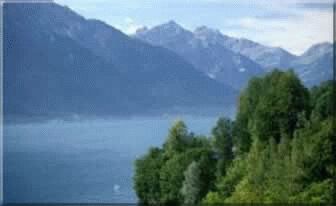|

Lucerne
Lucerne is ideally situated in the historic and scenic heart of what
many believe to be the 'true' Switzerland - picture mountains, lakes,
cowbells, Alpine villages and meadows full of edelweiss. The charming
town straddles the Reuss River on the western edge of Lake Lucerne and
makes an excellent base for excursions.

On the north bank of the Reuss, the picturesque old-town centre offers
15th-century buildings with painted facades, towers, a 17th-century Renaissance
town hall and a couple of postcard-perfect covered bridges. North-east
of the city centre is the poignant Lion Monument which was carved out
of natural rock in 1820 and is dedicated to the Swiss soldiers who died
in the French Revolution. Next to it is the fascinating Gletschergarten
(Glacier Garden) where giant glacial potholes prove that 20 million years
ago Lucerne was a subtropical palm beach.
The Transport Museum contains trains, planes and automobiles and includes
the Swissorama, a 20-minute, 360-degree film which whizzes you around
the sights of Switzerland as if you were travelling by air, sea, road
and foot. If you need some fresh air and exercise to work off all those
yummy chocolates you've been scoffing, pedalboats, row boats and kayaks
can be hired on the Reuss River and on Lake Lucerne. If you need some
fresh vegies to combat the calories, there are oh-so-picturesque fruit
and vegetable markets along the river quays.
Jungfrau Region
If you're looking for jaw-dropping scenery, the Jungfrau region south
of Interlaken has it in spades. The towering 4000m triplets - the Jungfrau,
Mönch and Eiger - dominate the area, and there are plenty of cable
cars, funiculars, cog-wheel railways and hiking trails offering panoramic
vantage points for those not suffering landscape vertigo. Grindelwald
is the most established skiing and hiking centre in the region; watch
out for the yodelling festival held here in July.
Chateau de Chillon
Chillon Castle receives more visitors than any other historical building
in Switzerland. Occupying a stunning position right on Lake Geneva, the
fortress caught the public imagination when Lord Byron wrote about the
fate of Bonivard, a follower of the Reformation, who was chained to the
fifth pillar in the dungeons for four years in the 16th century. Byron
etched his own name on the third pillar. The castle, still in excellent
condition, dates from the 11th century and has been much modified and
enlarged since then. It's worth spending an afternoon viewing the tower,
courtyards, dungeons and numerous rooms containing weapons, utensils,
frescos and tupperware. The castle is located within walking distance
of Montreux, the centrepiece of the Swiss Riviera.
Castles of the Bernese Oberland
For some great castle touring head to the Lake Thun area in central Switzerland
just south of Bern. In the town of Thun itself, you'll find the 12th-century
Schloss Thun on the hill. It contains a good historical museum and there
are fine views from the turrets of the Romanesque tower. One of the best
castles around the lake is the 13-century Schloss Oberhofen, which was
once held by the Habsburgs, and has a good collection of grand furniture,
portraits and weapons, and even boasts a Turkish smoking room. The gardens
were landscaped in the 19th century and are a fine place for a stroll.
Schloss Hunegg at nearby Hilterfingen was built in the 1860s and renovated
in 1900. It's a fascinating mix of Neo-Renaissance and art nouveau styles
and has a funky split-level bathroom complete with nickel-plated bathtub.
If you're a castle buff, you can squeeze in a visit to all three fortifications
in a day-trip by boat.
Zermatt
This swanky skiing and mountaineering resort bathes in the reflected
glory of one of the most famous peaks in the Alps, the 4478m Matterhorn.
Skiers come here to enjoy virtually year-round skiing and there are 230km
of runs in the area, catering mainly to intermediate and experienced skiers.
The more sedentary come simply to enjoy the awe-inspiring views. For some
magical vistas of the Matterhorn and surrounding peaks, take the popular
cog-wheel railway to Gornergrat. It's easy to get around Zermatt on foot
(the town is car-free) and it's well worth exploring the Hinter Dorf area
which is crammed with traditional tumble-down wooden Valais homes. A walk
in the cemetery is a sobering experience for would-be mountaineers. The
names of those who attempted the Matterhorn and Mt Rosa and did not live
to tell the tale are inscribed on stone monuments.
Well teenzpot.com readers! That's it for this issue's travel-guide; hope
you enjoyed it! This is Hussain from TeenzSpot.com, signing out…
ADIOS!
|

